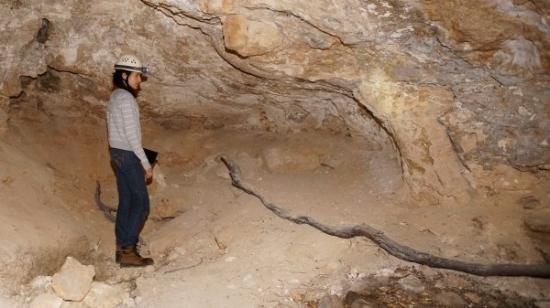Geoff Vivian / Science Network WA
Source - http://phys.org/news/2014-10-mammalian-bones-clues-early-human.html

Carly Monks records the dimensions of a cave shelter near Leeman, Western Australia. Credit: Ian McCann
Archaeologist Carly Monks will excavate caves near Leeman, in WA's Mid West, to find signs of human activity dating back 6,000 years to the mid-Holocene period.
A PhD candidate at UWA, Ms Monks is particularly interested in how early human activity—including bush burning, tuber cultivation and selective hunting of species for food—influenced the structure of mammalian communities.
"I've always been fascinated by the interactions between people and the landscape," Ms Monks says.
"More than just how the environments shape people, I'm interested in how people shape the environment."
Beginning this month, Ms Monks will excavate the floors of two unnamed limestone caves, using two-centimetre layers known as spit units, and test-sieving material through 5mm, 2mm and 1mm meshes.
She will send discovered bone fragments to Curtin University's TrEnD lab for DNA analysis and identification.
"With that I'll be able to reconstruct what those faunal communities were like at the time, and how people were impacting on the animals.
"If I get a 4,000-year profile that shows what the different faunal communities look like at each time, we can go back and reconstruct the environmental conditions that they needed."
Comparing leftovers
Ms Monks expects to find the discarded bones of animals hunted by early humans, and will compare these with smaller bones found in pellets regurgitated by cave-roosting owls over thousands of years.

Ms Monks will use ancient bone fragments to identify which species early humans were eating, and when.
"Owls tend to go for smaller prey like rats, mice, young bandicoots that might be missed by humans," she says.
"If humans are burning a lot of vegetation or changing the preferred habitat of a lot of these animals, then that will be reflected in a lot of owls' takings as well."
Ms Monks intends to use this data to build a picture of the local ecosystem's structure over time, and how early people operated within it.
The sites she will excavate are collapsed doline caves, which may have provided short-term shelter for early Amangu people.
"[The caves have] big shallow entrances, and they have quite wide overhangs, so you would have been able to fit a group of people in there quite comfortably," she says.
"It's still got some light coming in, you can have fires and be able to come and go quite easily."
Ms Monks says her research will shed new light on the long-term influence of human habitation on the ecology of Australia's south-west.